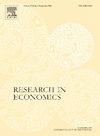The active role of the natural rate of unemployment
IF 1.3
Q3 ECONOMICS
引用次数: 0
Abstract
We propose that the natural rate of unemployment may have an active role in the business cycle, in contrast to a widespread view that the rate is fairly smooth and at most only weakly cyclical. We demonstrate that the tendency to treat the natural rate as near-constant would explain the surprisingly low slope of the Phillips curve. We observe that evidence is weak about this basic point—the evidence neither comes close to rejecting the conventional view nor does it reject a very different view in which fluctuations in the natural rate are associated with a substantial fraction of cyclical volatility. We show that the natural rate may have closely tracked the actual rate during the long recovery that began in 2009 and ended in 2019. We explain how the common finding of research in the Phillips-curve framework of low — often extremely low — response of inflation to unemployment could be the result of fairly close tracking of the natural rate and the actual rate in recoveries. Our interpretation of the data contrasts to that of many Phillips-curve studies, that conclude that inflation has little relation to unemployment.
自然失业率的积极作用
我们提出,自然失业率可能在商业周期中发挥积极作用,这与普遍认为失业率相当平稳,最多只是弱周期性的观点形成鲜明对比。我们证明,将自然率视为接近常数的倾向可以解释菲利普斯曲线的低斜率。我们观察到,关于这一基本点的证据是薄弱的——证据既没有接近于否定传统观点,也没有否定一个非常不同的观点,即自然利率的波动与很大一部分周期性波动有关。我们表明,在2009年开始并于2019年结束的长期复苏期间,自然利率可能与实际利率密切相关。我们解释了菲利普斯曲线框架下的低——通常是极低的——通货膨胀对失业的反应的共同研究发现,如何可能是相当密切地跟踪自然率和实际恢复率的结果。我们对数据的解释与许多菲利普斯曲线研究的结果形成了对比,后者得出的结论是通胀与失业几乎没有关系。
本文章由计算机程序翻译,如有差异,请以英文原文为准。
求助全文
约1分钟内获得全文
求助全文
来源期刊

Research in Economics
ECONOMICS-
CiteScore
1.40
自引率
0.00%
发文量
37
审稿时长
89 days
期刊介绍:
Established in 1947, Research in Economics is one of the oldest general-interest economics journals in the world and the main one among those based in Italy. The purpose of the journal is to select original theoretical and empirical articles that will have high impact on the debate in the social sciences; since 1947, it has published important research contributions on a wide range of topics. A summary of our editorial policy is this: the editors make a preliminary assessment of whether the results of a paper, if correct, are worth publishing. If so one of the associate editors reviews the paper: from the reviewer we expect to learn if the paper is understandable and coherent and - within reasonable bounds - the results are correct. We believe that long lags in publication and multiple demands for revision simply slow scientific progress. Our goal is to provide you a definitive answer within one month of submission. We give the editors one week to judge the overall contribution and if acceptable send your paper to an associate editor. We expect the associate editor to provide a more detailed evaluation within three weeks so that the editors can make a final decision before the month expires. In the (rare) case of a revision we allow four months and in the case of conditional acceptance we allow two months to submit the final version. In both cases we expect a cover letter explaining how you met the requirements. For conditional acceptance the editors will verify that the requirements were met. In the case of revision the original associate editor will do so. If the revision cannot be at least conditionally accepted it is rejected: there is no second revision.
 求助内容:
求助内容: 应助结果提醒方式:
应助结果提醒方式:


